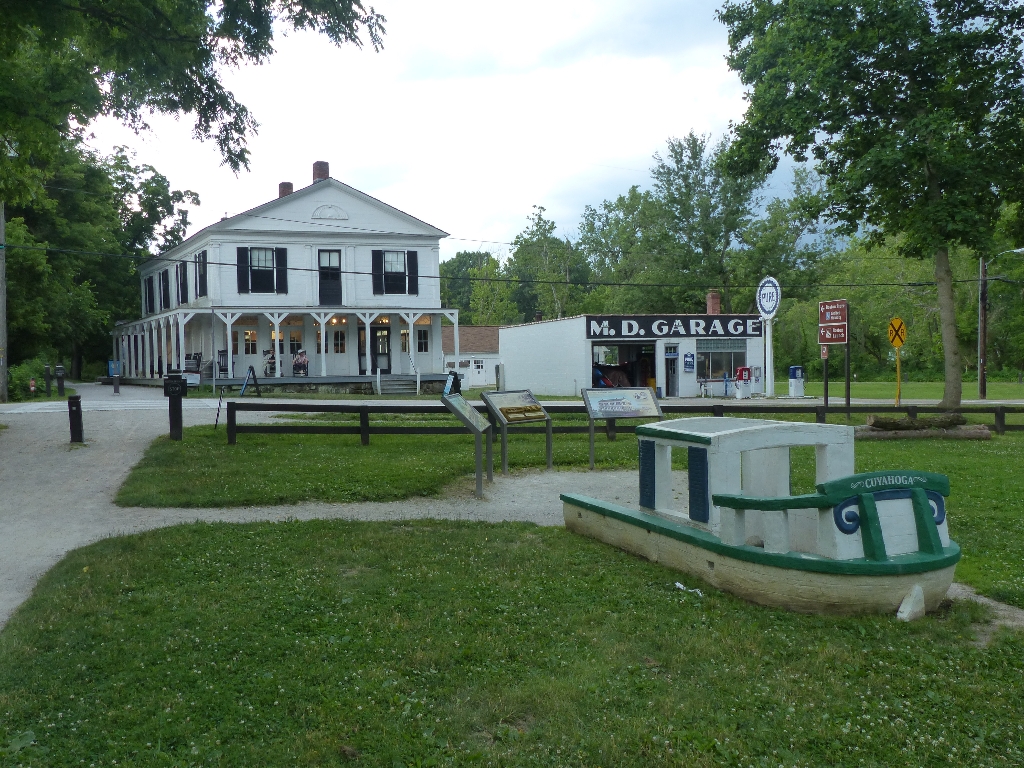
Boston boomed after the Ohio & Erie Canal opened in 1827. A cluster of outdoor exhibits features Boston’s canal era businesses, including its role in boat building. Boatyards produced the long, barge-like boats that carried passengers and freight. A play structure in the exhibit cluster lets people experience a scale model of a partial canal boat.
This exhibit cluster is also a good location to see some basic features of the canal. The exhibits are adjacent to the towpath. Today, it is a popular recreational trail. Historically, mules and horses walked the towpath to pull canal boats. These sure-footed animals powered the boats, which did not have motors. The now-dry canal ditch is on the other side of the towpath from the exhibits. Workers dug it by hand to be 40 feet wide and four feet deep.
During the canal heyday, about half of the boats on the canal were built in Boston and Peninsula. Boston had three boatyards in 1856, the year featured in a bird’s eye drawing of the village in the exhibits. The drawing shows a bustling boatyard on the far side of the canal from the exhibits, a blacksmith shop, and a lumberyard.
Canal boats included passenger packets and cargo boats. The latter are featured in the exhibits. The size and shape of a canal boat was determined by the smallest lock, which on the Ohio & Erie Canal is 75 feet long by 15 feet wide. The wide, flat-bottomed hull of the boats provided maximum space for cargo while allowing the boat to operate in the canal’s shallow water. Crew and passenger cabins were located at the bow and stern of the boat, while a structure in the middle served as stables for the mules.
Other businesses took advantage of the canal boom. Julian Edson had a sawmill and gristmill. Jim and Lucy Brown owned the Commercial Hotel, which stood in the location of MD Garage, as well as a small store.
The Boston Land and Manufacturing Company opened across the street along the towpath in 1835. Notice how the building is not square. Its side façade parallels the canal. Its front façade parallels the road. As a result, it has a rhomboid shape. Today, it houses a store with food and gifts operated by the Conservancy for Cuyahoga Valley National Park.
Bring yourself into the past by imagining how the sensory experience of Boston would have been different from today. Imagine the banging hammer of a blacksmith; the smell of wet, steamed wood coming from a boatyard; and the sight of work men loading a canal boat and well-dressed passengers hurrying into Commercial Hotel.
Fortune is fickle. While the town boomed in the 1830s, competition from trains had made an impact by the 1850s. By 1860, the Browns’ business ventures were over and a decade later, Edson’s had crashed as well. Boston would boom again. To learn more about that boom, cross the street to the exhibit adjacent to Boston Store or follow Boston Mills Road west over the Cuyahoga River to the Boston Mill Visitor Center.
To explore more canal era history, walk the towpath north less than 0.1 mile to Lock 32. An exhibit describes the role of locks in the canal system. Stumpy Basin, where boats could turn around or park, is one mile south along the towpath. Find comprehensive, family-friendly exhibits about the canal at Canal Exploration Center, located nine miles north along the Towpath Trail. It is open seasonally.
Is there something we missed for this itinerary?
Itineraries across USA


















































